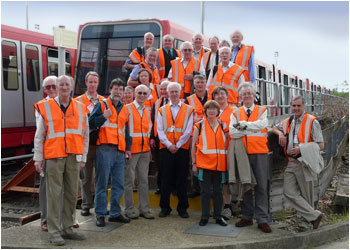Docklands Light Railway
When it opened in 1987 the Docklands Light Railway was thought by many to be little more than toy trains. Twenty years on it carries 60 million+ passengers p.a. and continues to expand.
It is a driverless railway that boasts near perfect punctuality. Initially conceived as a cheaper alternative than extending the Jubilee line the DLR has become a vital part of the infrastructure of the former rundown docklands.
The towering office blocks of Canary Wharf are at the centre of the original system. It has been extended westwards to a new terminus at Bank, eastwards to Beckton and south under the Thames to Lewisham. The new route to Woolwich requires another tunnel under the river. The first phase of this line as far as King George V is open and the tunnel boring completed. There is also work on a second line to Stratford for the 2012 Olympics.
Following the initial upgrade to 2-unit trains new 3-unit services are to be introduced from Bank to Lewisham in 2009.

Outing to DLR
10 May 2008
On Saturday, 10th May, a party of 25 members and friends visited London’s Docklands Light Railway. Most of the party travelled on the 08.34 train from Templecombe to Waterloo and from there caught a suburban train for the short journey to Lewisham. Here we made our way to the southernmost terminus of the Docklands Light Railway and travelled northwards, passing under the Thames in the tunnel from Greenwich to the Isle of Dogs, and alighting at Canary Wharf where we had an early lunch.
The futuristic station is surrounded by many of the towering office blocks which form the centre of the rejuvenated dockland area whilst at ground level are many shops, a supermarket, cafes and restaurants as well as pleasant small squares in which one can relax. We then continued on the DLR northwards to Poplar station where a short walk took us to the Poplar Depot and the ‘nerve centre’ of the Railway.
Here we were met by Mr Ralph Harding, Chief Engineer of the DLR, who was to be our guide and who had given us a fascinating insight into the Railway when he was our speaker in Wells in April 2007. At Poplar we were privileged to be able to spend a while watching the activities in the main operations room from which all the trains are controlled by computer and the 39 stations are supervised by means of CCTV.
The DLR is most unusual in that the trains are normally driverless and passengers are afforded an uninterrupted view from the front – or rear – of the train. The DLR, which opened in 1987, has been extended considerably and present work is concentrated on an extension to serve the 2012 Olympic Stadium site at Stratford. Services on the Railway are provided by two-coach articulated units, of which the DLR currently has 94 in service with a further 55 of a technically more-advanced design just being delivered. Trains are normally made up of two of these units coupled together and work is in hand to lengthen station platforms to enable three-unit trains to operate to cater for the vast number of passengers expected during the Olympics. The Games apart, the demand on the DLR has exceeded all expectations with 62 million passenger journeys being made in 2007, a figure expected to rise to 80 million in 2009.
To our delight Mr Harding had provided a special train (which unusually required the services of a driver) to take us from Poplar to the Railway’s other depot and workshops at the eastern end of the Railway at Beckton. The journey provided a fascinating view of many of the new buildings which are appearing in the eastern Docklands area, including the ExCel exhibition centre and the new University of East London. Two of the DLR stations – Gallions Reach and Cyprus – are most interesting as they are built within and below large road roundabouts.
Returning to Poplar we said our farewells to Mr Harding. Some of the party then returned to Waterloo for the train home by travelling on the section of the DLR which runs westwards towards the Tower of London before going underground to its terminus near the Bank of England, and then using the Waterloo & City line – affectionately known to Londoners as ‘The Drain’. Others opted to return by a later train from Waterloo, having made a detour to visit the superbly refurbished St. Pancras Station which now serves as the international terminus for the Eurostar trains running via the Channel Tunnel.



